New
As industrial hemp cultivation expands across the United States, farmers and researchers are working to understand insect pest pressures that affect the crop. While hemp was once thought to be relatively pest-resistant, recent field studies have shown that a wide range of insect pests can damage hemp plants, reduce yield, and affect quality. The presence and severity of insect pests can vary by geography, plant growth stage, and hemp variety.
Early-season pests (seedling to vegetative stage)
Redheaded Flea Beetle (Systena frontalis)
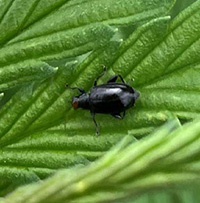
- Family: Chrysomelidae
- Identification: Small (0.2-0.24 inches), shiny black beetle with a distinct reddish-brown head and powerful hind legs for jumping.
- Damage:
- Adults feed on hemp leaves, creating irregular holes that have a “shot-hole” appearance.
- Heavy infestations may cause severe defoliation, stunted plant growth, and reduced photosynthesis.
- Young plants are especially vulnerable and may die if defoliated extensively.
Grape Colaspis (Colaspis brunnea)
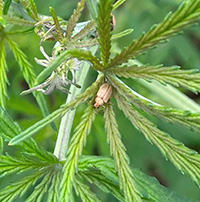
- Family: Chrysomelidae
- Identification: Tan-colored, oval beetle (0.12–0.16 inches) with shallow indentations on the wing covers; larvae are C-shaped white grubs.
- Damage:
- Adults: Chew small, rounded holes in leaves. Damage is typically scattered and often cosmetic, but it can be significant in high numbers.
- Larvae: Feed on the roots and root hairs of hemp plants underground, which can impair water and nutrient uptake.
- Root damage can lead to wilting, reduced vigor, poor plant establishment, increased susceptibility to drought or disease, and stunted plants.
Twostriped Grasshopper (Melanoplus bivittatus)
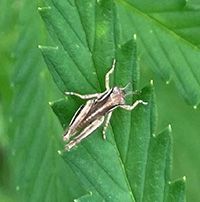
- Family: Acrididae
- Identification: Green or tan with black spines on the hind tibia (leg shank). There are two distinct yellow lines running along the length of the grasshopper’s back.
- Damage:
- Both nymphs and adults chew on hemp foliage.
- They consume large sections of leaves, often start from the edges of the leaf. In severe cases, only the midrib remains.
- May chew on tender stems, petioles, and young flower buds, particularly in dense populations.
- Heavy infestations can strip plants of their foliage and reduce photosynthesis, plant vigor and stunt growth, and decreased biomass and floral yield.
Mid-season pests (vegetative to early flowering stage)
Spotted Cucumber Beetle (Diabrotica undecimpunctata)
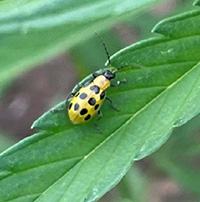
- Family: Chrysomelidae
- Identification: Yellow-green beetle (6–8 mm) with 12 black spots on wing covers. Larvae are white and worm-like.
- Damage:
- Adults feed on hemp foliage, petals, and pollen. Plants have holes and ragged edges on leaves and floral parts. Feeding on flowers can interfere with pollination and seed formation.
- Larvae (rootworms) burrow into the soil and feed on root hairs and root tips. This feeding weakens the root system. Root damage can lead to poor plant anchorage, lodging, stunted growth, and increased risk of root rot.
Tarnished Plant Bug (Lygus lineolaris)
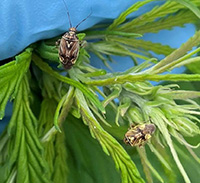
- Family: Miridae
- Identification: Small (5–6 mm), fast-moving bug with mottled brown color and distinctive yellow triangle on its back. Stink bugs may have similar damage.
- Damage:
- Uses piercing-sucking mouthparts to extract plant juices from young leaves, stems, buds, and flowers.
- Feeding causes chlorotic spots, leaf curling, stunted terminal growth, and distorted buds.
- Damage to developing buds can cause bud abortion and malformed flowers.
- Feeding wounds also make plants more susceptible to secondary infections.
Longhorn Beetle (Dectes texanus)
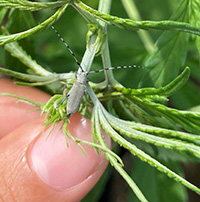
- Family: Lamiinae
- Identification: Grayish beetle with long antennae. Larvae are creamy white and bore into stems.
- Damage:
- Larvae bore into main stems and tunnel along the interior, where they feed selectively on the pith in the central core, weakening the plant structure. Tunneling can cause wilting, dieback, and breakage, especially when the plant experiences mechanical stress.
- Boring damage disrupts water and nutrient transport, which leads to reduced growth and yield.
- Infested stems may appear swollen or split, and internal galleries may become entry points for pathogens.
Late-season pests (flowering to maturity stage)
Cabbage Looper (Trichoplusia ni)
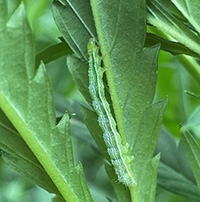
- Family: Noctuidae
- Identification: Green caterpillar with white stripes on the sides. The caterpillar moves in a characteristic looping motion.
- Damage:
- Caterpillars feed heavily on leaves, creating large, irregular holes.
- Feeding typically begins on the undersides of lower leaves and progresses upward.
- Severe infestations can strip plants of foliage, reduce photosynthesis, and overall plant health.
- Looper feeding on floral buds can deform or destroy marketable flower heads in CBD or dual-purpose varieties.
Japanese Beetle (Popillia japonica)
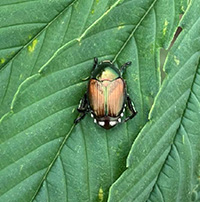
- Family: Scarabaeidae
- Identification: Metallic green beetle with bronze wing covers that is about 0.4–0.5 inches long.
- Damage:
- Adults skeletonize leaves by feeding between the veins, leaving behind only the leaf veins in a lace-like pattern.
- Feeding on flowers and tender shoots can reduce bud quality and disrupt reproductive development.
- Severe infestations can defoliate entire plants and particularly affect young plants or those in the flowering stage.
- Feeding damage often occurs in groups, as beetles aggregate using pheromones.
Green June Beetle (Cotinis nitida)
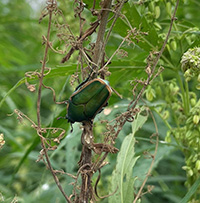
- Family: Scarabaeidae
- Description: Large, metallic green beetle with bronze wings that are active in mid-to-late summer.
- Damage:
- Adults feed on flowers and fruits. They gain entry in fruits by gouging with the horn on the front of the head and feed on the flesh of the fruit.
- Larvae (grubs) feed on decaying organic matter and roots; excessive larval populations can disturb the root zone.
- Root disturbance may cause wilting, uneven plant stands, and weak anchorage and kill the plant from bottom to up.
- Tunneling activity in soil can interfere with water infiltration and root aeration.
Spined Soldier Bug (Podisus maculiventris)
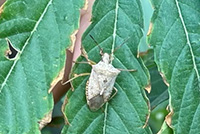
- Family: Pentatomidae
- Identification: Brownish predatory stink bug with spiny "shoulders" on the thorax.
- Damage:
- This is a beneficial predatory insect.
- It preys on pests such as caterpillars and beetle larvae, provide to natural biological control.
- Occasionally mistaken for harmful stink bugs, but it does not damage hemp.
Armyworm (Spodoptera spp.)
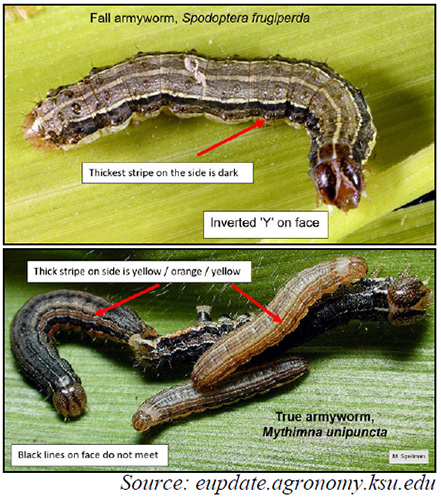
- Family: Scarabaeidae
- Species: Fall armyworm (Spodoptera frugiperda), true armyworm (Mythimna unipuncta).
- Identification:
- True Armyworm: Larvae are greenish-brown with dark stripes running lengthwise. Orange-brown head with dark honeycomb-like markings. Adult moth has mottled gray-brown forewings with small white dots and pale hindwings.
- Fall Armyworm: Larvae are brown to green with 4 distinct black dots arranged in a square on the last abdominal segment. Inverted “Y” marking on the head capsule. Adult moth has dark mottled brown front wings and silvery-white hindwings.
- Damage:
- Adults are nocturnal moths that do not directly damage hemp, but lay egg clusters on leaves, which hatch into larvae.
- Larvae (caterpillars) are the most destructive stage. They feed voraciously on hemp leaves, creating irregular holes, skeletonizing tissue, and stripping foliage down to the midribs. In later stages, they may bore into buds and flowers and contaminate them with silk and frass.
- Flower and bud feeding during late-season reduces grain yield and flower quality. Wounds caused by larvae predispose buds to fungal infections.
Integrated pest management for industrial hemp
Integrated Pest Management (IPM) is an ecological approach to pest control that combines multiple strategies to manage insects in a sustainable and economically viable way. For industrial hemp, limited labeled pesticides are available; therefore, IPM is especially important.
Prevention and cultural control
- Crop rotation: Avoid continuous planting in the same field to minimize soil-dwelling pests like rootworms.
- Field sanitation: Remove plant debris from the previous season to eliminate overwintering sites for pests.
- Weed control: Manage weeds inside and around fields to eliminate alternate hosts for pests like tarnished plant bugs and flea beetles.
- Planting time: Adjust planting dates to avoid peak pest emergence, especially for pests like grasshoppers or beetles.
Monitoring and early detection
- Scouting: Regularly inspect plants, especially during seedling and flowering stages. Look for feeding damage, frass, eggs, or adult insects.
- Traps: Use nets, sticky traps, and pheromone traps for early detection of specific pests (e.g., looper moths, Japanese beetles, cucumber beetles but not for Green June Beetle).
- Record-keeping: Record pest populations and crop stages to make future decisions.
Economic thresholds
- Action thresholds: Apply control measures when pest populations reach levels that could cause economic loss.
Biological control
- Conservation of beneficials: Avoid broad-spectrum insecticides to protect natural predators like:
- Lady beetles – aphid control
- Spined soldier bugs – caterpillar and beetle larvae control
- Parasitic wasps – looper and moth egg control
Mechanical and physical controls
- Row covers: Use insect netting or floating row covers during early growth to protect against flea beetles and cucumber beetles.
- Trap crops: Use preferred plants (e.g., sunflowers or alfalfa) near hemp fields to attract and trap pests.
Chemical control (last solution)
- Use products approved by the United States Environmental Protection Agency (EPA) for industrial hemp. Since December 2019, EPA has approved 49 pesticides for use in hemp. Forty-six of the products are biopesticides, and one is a conventional pesticide.
- A detailed list of pesticides and their active ingredients approved for industrial hemp can be found at the EPA site.
References and resources
- Bekelja, M.B., & Day, E. (2022). Cabbage Looper. Virginia Cooperative Extension.
- Colorado State University
- Dellinger, T.A., & Day, E. (2021). Tarnished Plant Bug. Virginia Cooperative Extension
- Haack, R.A. (2015). Life History Patterns of Longhorned Beetles (Cerambycidae): A Worldwide Perspective.
- Deynzer, K., Huval, F., Carlton, C., & Reagan, T.E. (2021). Diabrotica undecimpunctata, Spotted Cucumber Beetle (Coleoptera: Chrysomelidae). LSU AgCenter
- Kansas State University Agronomy eUpdates (2021).
- Mississippi State University Extension (2019).
- Orr, D. (2019). Spined Soldier Bug. NC State Extension.
- Purdue Extension (2021).
- Utah State University Extension
- Whitworth, J. (2022). Grasshoppers. K-state Research and Extension.